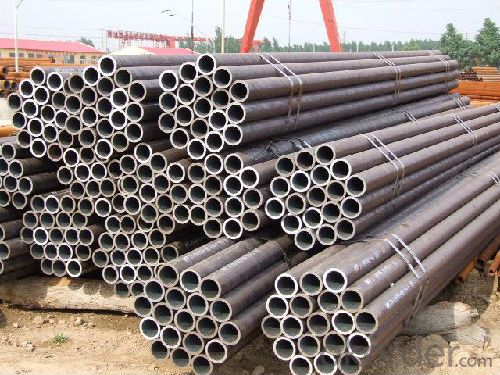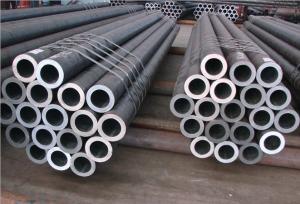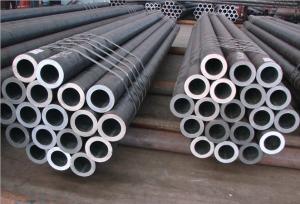Small Diameter Seamless Stainless Steel Tube
- Loading Port:
- Tianjin
- Payment Terms:
- TT or LC
- Min Order Qty:
- 25 m.t.
- Supply Capability:
- 10000 m.t./month
OKorder Service Pledge
OKorder Financial Service
You Might Also Like
We are company that have many years experience and professional manager team and engineer team and sales team, sure we will provide you high quality of pipe and professioanl service.
Seamless pipe possesses a hollow section and without seam around the strip steel. It is made with solid bar or steel ingot by perforating machine. As the facture process does not include any welding, seamless pipes are considered to be stronger and more durable. Generally speaking, seamless pipe has better pressure resistance and security than other classifications, and was usually more easily available than welded pipe.
2、Main Features of the Seamless Pipe:
• High working accuracy
• High strength
• Small inertia resistance
• Strong therming dissipine ability
• Good appearance
• Reasonble price
3、Seamless Pipe Specification:
Standard | GB, DIN, ASTM ASTM A106-2006, ASTM A53-2007 |
Grade | 10#-45#, 16Mn 10#, 20#, 45#, 16Mn |
Thickness | 8 - 33 mm |
Section Shape | Round |
Outer Diameter | 133 - 219 mm |
Place of Origin | Shandong, China (Mainland) |
Secondary Or Not | Non-secondary |
Application | Hydraulic Pipe |
Technique | Cold Drawn |
Certification | API |
Surface Treatment | factory state or painted black |
Special Pipe | API Pipe |
Alloy Or Not | Non-alloy |
Length | 5-12M |
Outer Diameter | 21.3-610mm |
Grade | 20#, 45#, Q345, API J55, API K55, API L80, API N80, API P110, A53B |
Standard | ASME, ASTM |
1) Material:20#(ASTM A 106/A53 GRB.API5LGRB,GB),45#,16Mn,10#.
2) Specification range: OD: 21.3-610mm, WT:6-70mm, length:6-12m or according to the requirement of clients.
3) Executive standards: GB, ASME API5L.ASTM A 106/A53,Despite of the above standards, we can also supply seamless steel pipe with standard of DIN, JIS, and so on, and also develop new products according to the requirements of our clients!
4) Surface: black lacquered, varnish coating or galvanized.
5) Ends: Beveled or square cut, plastic capped, painted.
6) Packing: bundles wrapped with strong steel strip, seaworthy packing.
4、Packaging & Delivery:
Packaging Details: | seaworthy package, bundles wrapped with strong steel strip |
Delivery Detail: | 15-30days after received 30%TT |
5、FAQ of Seamless Pipe:
①How is the quality of your products?
We have many years business experience in this area, and we have professional engineer and manager team and sure we can provide you high quality production and professional service.
②How about price?
Yes, we are factory and be able to give you lowest price below market one, and we have a policy that “ for saving time and absolutely honest business attitude, we quote as lowest as possible for any customer, and discount can be given according to quantity”,if you like bargain and factory price is not low enough as you think, just don’t waste your time.Please trust the quotation we would give you, it is professional one.
③Why should you chose us?
We can give you both.Additionally, we can also offer professional products inquiry, products knowledge train(for agents), smooth goods delivery, exellent customer solution proposals.Our service formula: good quality+good price+good service=customer’s trust
SGS test is available, customer inspection before shipping is welcome, third party inspection is no problem.
6、Seamless Pipe Images:


- Q:What are the common joining methods for stainless steel pipes?
- The common joining methods for stainless steel pipes include welding, threaded connections, and flanged connections. Welding is the most common and widely used method for joining stainless steel pipes. It involves melting the ends of the pipes and fusing them together using a welding electrode. The weld can be made using various types of welding techniques such as TIG (Tungsten Inert Gas) welding, MIG (Metal Inert Gas) welding, or Stick welding, depending on the specific requirements of the application. Threaded connections are another popular joining method for stainless steel pipes, especially for smaller diameter pipes. This method involves threading the ends of the pipes and using threaded fittings to connect them. Threaded connections provide a secure and leak-proof joint, and they are relatively easy to install and disassemble when necessary. Flanged connections are used for larger diameter stainless steel pipes or when there is a need for easy disassembly and reassembly. This method involves attaching flanges to the ends of the pipes and connecting them using bolts and gaskets. Flanged connections provide a rigid and reliable joint, and they are commonly used in industrial applications where frequent maintenance or replacement is required. It is important to note that the choice of joining method for stainless steel pipes depends on various factors such as the pipe diameter, pressure and temperature requirements, accessibility, and the specific application. Consulting with a qualified engineer or professional is recommended to ensure the most appropriate joining method is selected for a specific project.
- Q:Can stainless steel pipes be used for food storage tanks?
- Yes, stainless steel pipes can be used for food storage tanks. Stainless steel is a highly durable and corrosion-resistant material that is safe for storing food and beverages. It is non-reactive and does not leach any harmful substances into the stored products, making it an ideal choice for food storage tanks.
- Q:Can stainless steel pipes be used for nuclear power applications?
- Yes, stainless steel pipes can be used for nuclear power applications. Stainless steel is known for its corrosion resistance, high strength, and ability to withstand high temperatures, making it suitable for various demanding environments, including nuclear power plants. Additionally, stainless steel's low reactivity with nuclear materials and its ability to maintain structural integrity under radiation exposure further make it a preferred choice for nuclear power applications.
- Q:Can stainless steel pipes be insulated for soundproofing?
- Yes, stainless steel pipes can be insulated for soundproofing. Insulating stainless steel pipes can help reduce the transmission of noise and vibrations through the pipes. There are various methods and materials that can be used to insulate the pipes, such as acoustic wraps, foam insulation, or mass-loaded vinyl. These materials are designed to absorb or block sound waves, preventing them from traveling along the pipes and into the surrounding environment. Properly insulating stainless steel pipes can significantly improve soundproofing in residential, commercial, or industrial settings, making them an effective solution for noise reduction.
- Q:Stainless steel pipe chamfering how to process?
- The use of fast machine chamfering is the trend of mechanical industry. The utility model overcomes the defects of the processing of the existing machinery and the electric tool, and has the advantages of convenience, quick and accuracy, and is the best choice for chamfering the metal object at present. According to the chamfer, it needs to be divided into straight line, chamfer and curve chamfer.
- Q:Can stainless steel pipes be used for underground sewer lines?
- Yes, stainless steel pipes can be used for underground sewer lines. Stainless steel is a highly durable and corrosion-resistant material, making it an ideal choice for applications in harsh environments such as underground sewer systems. It offers excellent resistance to chemicals, moisture, and other corrosive substances commonly found in sewer lines. Additionally, stainless steel pipes have a long lifespan and require minimal maintenance, making them a cost-effective option in the long run. However, it is important to consider the specific requirements and regulations of the local sewer system before selecting stainless steel pipes for underground applications.
- Q:Can stainless steel pipes be surface treated?
- Yes, stainless steel pipes can be surface treated. Surface treatment is often done to improve the aesthetics, corrosion resistance, and durability of stainless steel pipes. Common surface treatment methods for stainless steel pipes include passivation, electropolishing, pickling, and applying various coatings. Passivation involves the removal of impurities from the surface of the stainless steel, creating a protective oxide layer that enhances corrosion resistance. Electropolishing is an electrochemical process that smooths and polishes the surface of stainless steel pipes, improving their appearance and reducing the likelihood of bacterial growth. Pickling involves the removal of scale and oxide layers from the surface by using acid solutions. Coatings such as powder coating, paint, or plating can also be applied to stainless steel pipes to provide additional protection against corrosion, enhance appearance, or meet specific requirements. Overall, surface treatment options for stainless steel pipes are diverse and can be tailored to meet the desired functional and aesthetic needs.
- Q:How do you calculate the expansion of stainless steel pipes?
- To calculate the expansion of stainless steel pipes, you need to consider the coefficient of thermal expansion (CTE) of the material. The CTE is a measure of how much a material expands or contracts when subjected to temperature changes. First, determine the initial length of the stainless steel pipe. This is the length of the pipe at the starting temperature. Next, determine the final temperature at which the pipe will be operating. This is the temperature at which you want to calculate the expansion. Find the CTE value for the particular grade of stainless steel used in the pipe. The CTE is typically given in units of per degree Celsius (or per degree Fahrenheit). Multiply the initial length of the pipe by the CTE value and then multiply it by the change in temperature. This will give you the expansion or contraction of the pipe in the given temperature range. For example, let's say you have a stainless steel pipe with an initial length of 10 meters, a CTE of 17 x 10^-6 per degree Celsius, and you want to calculate the expansion at a final temperature of 100 degrees Celsius. The change in temperature would be 100 degrees Celsius (final temperature) minus the initial temperature. Expansion = Initial Length * CTE * Change in Temperature Expansion = 10 meters * 17 x 10^-6 per degree Celsius * 100 degrees Celsius Expansion = 0.0017 meters or 1.7 millimeters Therefore, the stainless steel pipe would expand by 1.7 millimeters when subjected to a temperature increase of 100 degrees Celsius. It's important to note that this calculation assumes a uniform expansion along the entire length of the pipe. In reality, thermal expansion may vary due to factors such as pipe diameter, wall thickness, and other structural considerations. Therefore, it's recommended to consult with industry standards or engineering references for more accurate calculations in specific applications.
- Q:Can stainless steel pipes be used for pharmaceutical storage?
- Indeed, pharmaceutical storage can utilize stainless steel pipes. Given its exceptional durability and resistance to corrosion, stainless steel proves to be an excellent choice for preserving pharmaceutical products. Not only is it effortlessly cleaned, but it also upholds the integrity of stored materials without any adverse reactions to the pharmaceutical substances. Furthermore, the smooth surfaces of stainless steel pipes effectively hinder the buildup of bacteria and contaminants. In light of this, stainless steel pipes emerge as an optimal solution for pharmaceutical storage, where the utmost importance is placed on maintaining hygiene and purity.
- Q:Can stainless steel pipes be insulated with polyvinylidene fluoride?
- Yes, stainless steel pipes can be insulated with polyvinylidene fluoride (PVDF). PVDF is a highly durable and temperature-resistant polymer that is commonly used for insulation purposes. It has excellent chemical resistance, UV stability, and flame retardant properties, making it suitable for insulating stainless steel pipes in various applications. PVDF insulation can help prevent heat loss or gain, protect against corrosion, and provide additional mechanical protection to the stainless steel pipes.
1. Manufacturer Overview |
|
|---|---|
| Location | |
| Year Established | |
| Annual Output Value | |
| Main Markets | |
| Company Certifications | |
2. Manufacturer Certificates |
|
|---|---|
| a) Certification Name | |
| Range | |
| Reference | |
| Validity Period | |
3. Manufacturer Capability |
|
|---|---|
| a)Trade Capacity | |
| Nearest Port | |
| Export Percentage | |
| No.of Employees in Trade Department | |
| Language Spoken: | |
| b)Factory Information | |
| Factory Size: | |
| No. of Production Lines | |
| Contract Manufacturing | |
| Product Price Range | |
Send your message to us
Small Diameter Seamless Stainless Steel Tube
- Loading Port:
- Tianjin
- Payment Terms:
- TT or LC
- Min Order Qty:
- 25 m.t.
- Supply Capability:
- 10000 m.t./month
OKorder Service Pledge
OKorder Financial Service
Similar products
New products
Hot products
Hot Searches
Related keywords





























